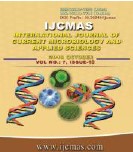


 National Academy of Agricultural Sciences (NAAS)
National Academy of Agricultural Sciences (NAAS)

|
PRINT ISSN : 2319-7692
Online ISSN : 2319-7706 Issues : 12 per year Publisher : Excellent Publishers Email : editorijcmas@gmail.com / submit@ijcmas.com Editor-in-chief: Dr.M.Prakash Index Copernicus ICV 2018: 95.39 NAAS RATING 2020: 5.38 |
Pine trees are evergreen growing at average height of 15-45 m with a diameter of up to 1.2 m. Pine needle are better known as Peerul in Uttrakhand. Pine needles, are adult leaves, which are green bundled in clusters with diameter of 1.5 mm and up to 20 cm length. Total pine needles available in India are 2.7 million tonnes per year (Pandey et al., 2011). Total pine needles available in India is 2.7 million tonnes per year, in India pine forests are widely found in the Indian Himalayan namely, Jammu & Kashmir, Himachal Pradesh, Uttarakhand, Sikkim, Arunachal Pradesh, Meghalaya, Nagaland, Manipur, Mizoram, Tripura, and the hill regions of 2 states viz. Assam and West Bengal - comprising about 95 districts of the country where found pine needle in adequate quantity (Bisht et al., 2014). The availability of cellulose is more than 50% in pine needle thus its utilization for packaging material can be explored for value added utilization of pine needles (Lal et al., 2013). The utility of bio based (pine needles) packaging materials as a potential alternative choice for petrochemical derived plastic is imperative for environment waste management and health safety concern. Pine Needles fall on the forest floor and make a thick layer since their decomposition is slow due to prevalent climatic conditions. Thick layer of un-decomposed needles is a major source of ground fires. Attempts have been made to use these needles to develop packaging materials for food materials. The experiments were performed on the varying amount of pine needles ranges from 50 to 100g with constant particles size, varying amount of pulp prepared from waste cardboard from 10 to 50g with constant plasticizer blended together. The prepared sample was compressed at constant pressure, holding time and temperature in order to obtained desirable mechanical properties of packaging material suitable for food packaging.
 |
 |
 |
 |
 |